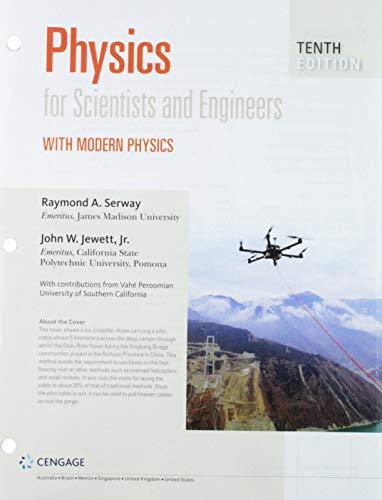
Review. You can think of the work–kinetic energy theorem as a second theory of motion, parallel to Newton’s laws in describing how outside influences affect the motion of an object. In this problem, solve parts (a), (b), and (c) separately from parts (d) and (e) so you can compare the predictions of the two theories. A 15.0-g bullet is accelerated from rest to a speed of 780 m/s in a rifle barrel of length 72.0 cm. (a) Find the kinetic energy of the bullet as it leaves the barrel. (b) Use the work–kinetic energy theorem to find the net work that is done on the bullet. (c) Use your result to part (b) to find the magnitude of the average net force that acted on the bullet while it was in the barrel. (d) Now model the bullet as a particle under constant acceleration. Find the constant acceleration of a bullet that starts from rest and gains a speed of 780 m/s over a distance of 72.0 cm. (e) Modeling the bullet as a particle under a net force, find the net force that acted on it during its acceleration. (f) What conclusion can you draw from comparing your results of parts (c) and (e)?
Trending nowThis is a popular solution!

Chapter 7 Solutions
Bundle: Physics For Scientists And Engineers With Modern Physics, Loose-leaf Version, 10th + Webassign Printed Access Card For Serway/jewett's Physics For Scientists And Engineers, 10th, Single-term
Additional Science Textbook Solutions
Organic Chemistry
Brock Biology of Microorganisms (15th Edition)
Introductory Chemistry (6th Edition)
Fundamentals Of Thermodynamics
Laboratory Experiments in Microbiology (12th Edition) (What's New in Microbiology)
Chemistry: An Introduction to General, Organic, and Biological Chemistry (13th Edition)
- A small turtle moves at a speed of 697. furlong/fortnight. Find the speed of the turtle in centimeters per second. Note that 1.00 furlong = 220. yards, 1.00 yard = 3.00 feet, 1.00 foot = 12.0 inches, 1.00 inch = 2.54 cm, and 1.00 fortnight = 14.0 days.arrow_forwardThe landmass of Sokovia lifted in the air in Avengers: Age of Ultron had a volume of about 1.98 km3. What volume is that in m3?arrow_forwardA fathom is a unit of length, usually reserved for measuring the depth of water. A fathom is exactly 6.00 ft in length. Take the distance from Earth to the Moon to be 252,000 miles, and use the given approximation to find the distance in fathoms. 1 mile = 5280 ft. (Answer in sig fig.)arrow_forward
- No chatgpt pls will upvotearrow_forwardOne of the earliest video games to have a plot, Zork, measured distances in “Bloits” where 1 Bloit was defined as the distance the king’s favorite pet could run in one hour, 1,090 m. In the same game the king has a statue made that is 9.00 Bloits high. What is this in meters?arrow_forwardNo chatgpt pls will upvotearrow_forward
- No chatgpt pls will upvotearrow_forwardDefination of voltagearrow_forwardAt point A, 3.20 m from a small source of sound that is emitting uniformly in all directions, the intensity level is 58.0 dB. What is the intensity of the sound at A? How far from the source must you go so that the intensity is one-fourth of what it was at A? How far must you go so that the sound level is one-fourth of what it was at A?arrow_forward
- Make a plot of the acceleration of a ball that is thrown upward at 20 m/s subject to gravitation alone (no drag). Assume upward is the +y direction (and downward negative y).arrow_forwardLab Assignment #3 Vectors 2. Determine the magnitude and sense of the forces in cables A and B. 30° 30° 300KN 3. Determine the forces in members A and B of the following structure. 30° B 200kN Name: TA: 4. Determine the resultant of the three coplanar forces using vectors. F₁ =500N, F₂-800N, F, 900N, 0,-30°, 62-50° 30° 50° F₁ = 500N = 900N F₂ = 800Narrow_forwardLab Assignment #3 Vectors Name: TA: 1. With the equipment provided in the lab, determine the magnitude of vector A so the system is in static equilibrium. Perform the experiment as per the figure below and compare the calculated values with the numbers from the spring scale that corresponds to vector A. A Case 1: Vector B 40g Vector C 20g 0 = 30° Vector A = ? Case 2: Vector B 50g Vector C = 40g 0 = 53° Vector A ? Case 3: Vector B 50g Vector C 30g 0 = 37° Vector A = ?arrow_forward
 Principles of Physics: A Calculus-Based TextPhysicsISBN:9781133104261Author:Raymond A. Serway, John W. JewettPublisher:Cengage Learning
Principles of Physics: A Calculus-Based TextPhysicsISBN:9781133104261Author:Raymond A. Serway, John W. JewettPublisher:Cengage Learning Physics for Scientists and Engineers with Modern ...PhysicsISBN:9781337553292Author:Raymond A. Serway, John W. JewettPublisher:Cengage Learning
Physics for Scientists and Engineers with Modern ...PhysicsISBN:9781337553292Author:Raymond A. Serway, John W. JewettPublisher:Cengage Learning Physics for Scientists and EngineersPhysicsISBN:9781337553278Author:Raymond A. Serway, John W. JewettPublisher:Cengage Learning
Physics for Scientists and EngineersPhysicsISBN:9781337553278Author:Raymond A. Serway, John W. JewettPublisher:Cengage Learning Glencoe Physics: Principles and Problems, Student...PhysicsISBN:9780078807213Author:Paul W. ZitzewitzPublisher:Glencoe/McGraw-Hill
Glencoe Physics: Principles and Problems, Student...PhysicsISBN:9780078807213Author:Paul W. ZitzewitzPublisher:Glencoe/McGraw-Hill University Physics Volume 1PhysicsISBN:9781938168277Author:William Moebs, Samuel J. Ling, Jeff SannyPublisher:OpenStax - Rice University
University Physics Volume 1PhysicsISBN:9781938168277Author:William Moebs, Samuel J. Ling, Jeff SannyPublisher:OpenStax - Rice University Physics for Scientists and Engineers: Foundations...PhysicsISBN:9781133939146Author:Katz, Debora M.Publisher:Cengage Learning
Physics for Scientists and Engineers: Foundations...PhysicsISBN:9781133939146Author:Katz, Debora M.Publisher:Cengage Learning





